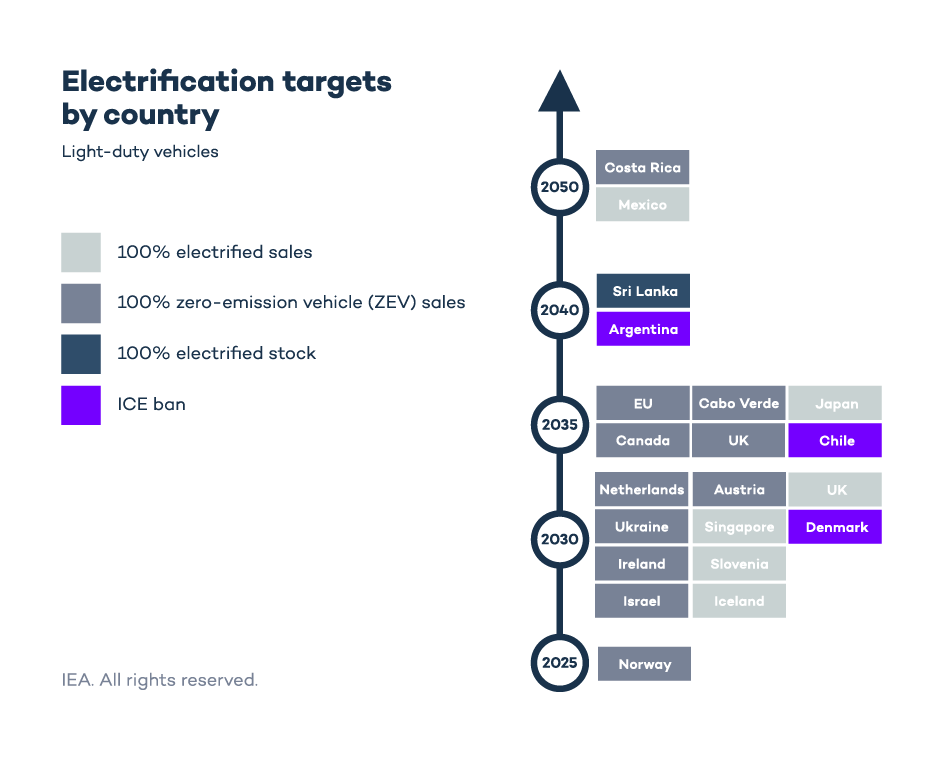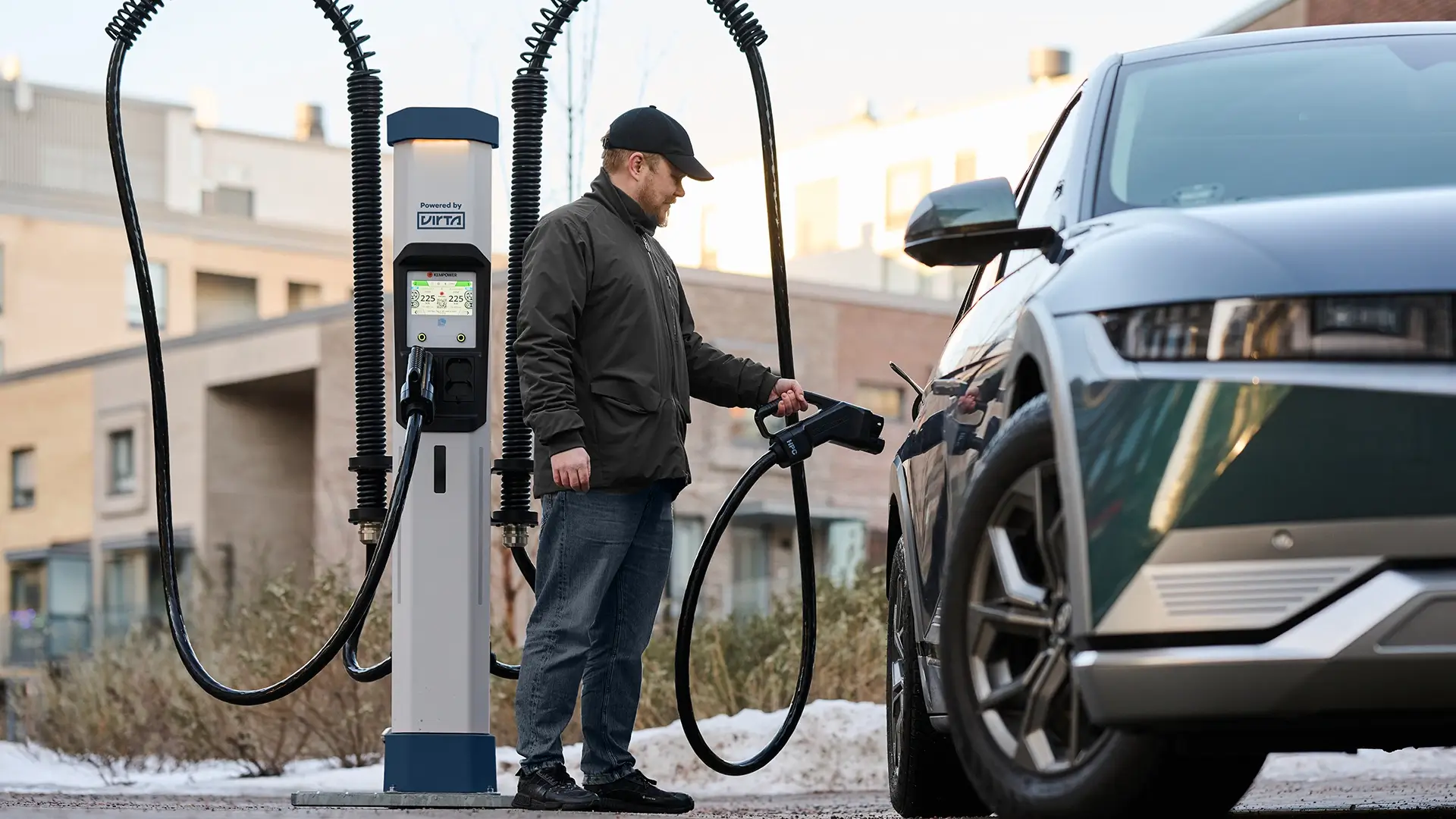Here's how EU legislation accelerates the EV revolution
Europe has an ambitious goal to become a climate-neutral continent by 2050. The European Commission has been introducing new legislation proposals to achieve this target. Many of them target mobility.
By 2030, the European electric vehicle fleet is supposed to reach 40 million – a massive increase from the current +8 million EVs roaming the European roads. Achieving this goal demands a set of regulations and targets to steer states, companies, and consumers in the right direction.
”Transport represents almost a quarter of Europe’s greenhouse gas emissions, so boosting e-mobility is crucial to achieving climate goals. The charging infrastructure needs to be aligned with the new targets,” Miapetra Kumpula-Natri, a Finnish member of the European Parliament, describes the ambitions.
Kumpula-Natri was a guest speaker in our webinar on e-mobility and energy management in real estate.
Currently, the European Union promotes the rise of electric mobility in multiple ways, from pushing car manufacturers to produce low-emission vehicles to supporting the development of comprehensive charging infrastructure.
The most prominent legislation affecting the development of charging infrastructures across the continent is the Alternative Fuels Infrastructure Regulation, or shortly AFIR.
AFIR is mainly supposed to stabilise the EV charging environment in Europe by providing common standards and guidelines to all the Member States and its EV charging market players.
Alternative Fuels Infrastructure Regulation (AFIR): A summary
AFIR targets focus not only on road transportation but also on setting standards for deploying alternative fuels in maritime and air transport. In this article, however, we focus on road transport and, more specifically, on electricity-powered vehicles.
1. The 60 km rule
One of the most prominent parts of the regulation is the ’60 km rule’. The Member States must install a fast charging station of at least 150 kW every 60 kilometres along the trans-European transport network (TEN-T).
Additionally, the regulation mandates a charging capacity of at least 1.3 kW per registered battery-powered vehicle (BEV).
For heavy-duty vehicles, the 60 km rule stays; however, the minimum output of the charger must be 350 kW.
2. Ad hoc payments
There has been a lot of discussion around EV charging payment options in the industry in the past few years. An easy-to-use payment process is integral for a positive user experience. The AFIR recognises that and mandates the possibility of an ad-hoc card payment at every EV charger above 50 kW.
3. Pricing transparency
So far, a common standard regarding EV charging pricing has been missing and charging providers have been able to set their prices in several ways, based on time, energy, the combination of both or with a fixed rate. This complexity needs to be clarified for EV drivers.
To ensure consistency and transparency, AFIR states that at charging points above 50 kW, pricing should be energy-based, i.e. per kWh and always clearly indicated to the EV driver before the start of the charging session.
4. Open data
Consumers must have unrestricted access to full information on the availability, location, waiting time, operational status and price at different charging stations.
Access to open data is crucial in achieving interoperability or the ability of any electric vehicle to charge at any charging station. This is important in making the EV charging ecosystem as accessible and open as possible.
5. Smart charging
Smart charging or the ability of an EV charger to communicate with its CPMS (charge point management system) via the cloud enables remote monitoring and managing of the charging devices to optimise energy consumption.
This is beneficial not only for the electricity system, which needs to stay balanced and healthy but also for the EV driver. AFIR mandates all public EV charging stations to have the ability to charge smartly.
Other examples of relevant EU legislation
EU-level measures affect each and every sector. Much of the EV charging infrastructure actions are being taken in the real estate sector. Building owners are required to prepare conditions for cars to be plugged in.
“With these legislative proposals, there is a momentum to create a comprehensive and smart EV charging infrastructure that will be, as much as possible, based on renewables, and will support the demand-response of the smart grid,” Kumpula-Natri declaims.
The Energy Performance of the Buildings Directive (EPBD)
The revised Energy Performance of the Buildings Directive is a must-know for all real estate sector actors. Depending on the purpose of the building, EPBD obligates new buildings and buildings undergoing major renovations to either install charging stations or ensure the installation of ducting infrastructure in parking spaces. The Directive sets requirements for the number of charging points required per parking space in residential and non-residential buildings.
At the same time, it forces the installation of smart charging points, meaning that the chargers should be capable of reacting to signals from the grid. Smart charging can contribute to building energy efficiency and supporting the integration of renewable energy. EPBD also mentions introducing bi-directional charging where appropriate.
Furthermore, EPBD forces all Member States to eliminate regulatory barriers to deploying charging points in all buildings, especially residential ones.
The Directive will be adapted to national laws in 2025.
The Energy Efficiency Directive (EED)
Current energy efficiency improvements should reduce at least 32.5% of the EU’s overall energy consumption by 2030. Even though the EU recognises the percentage should be higher. Hastening the shift to more efficient electric vehicles and increasing the efficiency of the existing vehicle population is how the EU aims to reach the target.
In practice, multiple countries have already taken concrete steps to speed up the transition towards e-mobility with national zero-emission mobility targets or by introducing scrappage schemes and rewards for old cars. The Directive has already been implemented in member countries and can and should be supported with ambitious transport policies that support the EU’s 2030 energy efficiency target.

The Renewable Energy Directive (RED)
The European Union must accelerate the move towards using clean energy if it wants to reach its goal of climate neutrality by 2050. The Renewable Energy Directive (RED) provides a legal framework for developing clean energy in all sectors of the economy.
RED also includes a framework for facilitating electrification in transport and the promotion of electric vehicles and smart charging.
The Directive was revised in 2023 when the renewable energy target was raised from 40% to 42.5% by 2030.
The deadline for RED transposition in the Member States is May 2025, with some provisions having a shorter deadline of July 2024.
EU Taxonomy
The EU taxonomy is a classification system that establishes a list of environmentally sustainable economic activities. The EU taxonomy is a critical enabler to scale up sustainable investments and to implement the European Green Deal. This EU classification system means that industry operators must extensively report how they have reduced, prevented, and managed emissions to have access to financing.
Electricity Market Design Directive and Regulation
Furthermore, the Electricity Market Design Directive encourages Member States to introduce smart electricity-metering systems.
”Smart homes, villages, and cities can place the consumer at the centre of the energy system. As local and renewable energy sources will decarbonise energy usage, smart grids are needed to balance the system,” Kumpula-Natri explains.
Smartness in EV charging unravels the possibility of electric vehicles to provide stability and flexibility to the grid. With MDD and smart charging systems, consumers can use, generate, store, and even sell energy without redundant charges.
Get help in planning your smart electric future
The many pieces of EU legislation send a loud and clear message: electric vehicle charging is a solution that needs to be embraced. Positive environmental effects aside, businesses in various sectors also need to keep up with the sheer demand for EV charging services by their customers to stay relevant.
EV charging is a great potential revenue generator: chargers attract new customers, bring added value to your business and support the loyalty of your current clientele.
Virta can help you fulfil legislative requirements and participate in the EV revolution. Let’s work out a plan to implement smart EV charging as a part of your future.
New content alerts
You may also like
These related stories
/close-up-ev-charging-cable-and-white-electric-vehicle.webp?width=1920&height=1080&name=close-up-ev-charging-cable-and-white-electric-vehicle.webp)
Here's how EV drivers charge their cars across Europe

How the EU plans to boost the development of home EV charging

NIS2 Directive: How to comply with the EU-wide legislation
/business-conference-speakers-discussion.webp?width=1920&height=1080&name=business-conference-speakers-discussion.webp)


